Exterior to the Extreme Painting
Painting where it’s hot, painting where it’s cold
22 March, 2024
Painting where it’s hot, painting where it’s cold
22 March, 2024
Every city has its weather jokes: “If you don’t like the weather, wait five minutes.” “We had all four seasons here, and it’s only noon.” Seriously though, extreme weather can call for extreme measures, and it’s important to take precautions so that neither your paint nor your painters overheat or freeze. We’ve traveled to the ends of the earth to see how it’s done.
Erick Gatcomb, proprietor of Gatcomb Painting & Design, is like Cheer laundry detergent, he works in all temperatures, but as a lifelong resident of Hancock, Maine, near Bar Harbor, he’s had to learn — sometimes the hard way — about applying paint in cold or soon-to-be-cold temperatures before taking off for a hot time in the old town. Here are his observations:
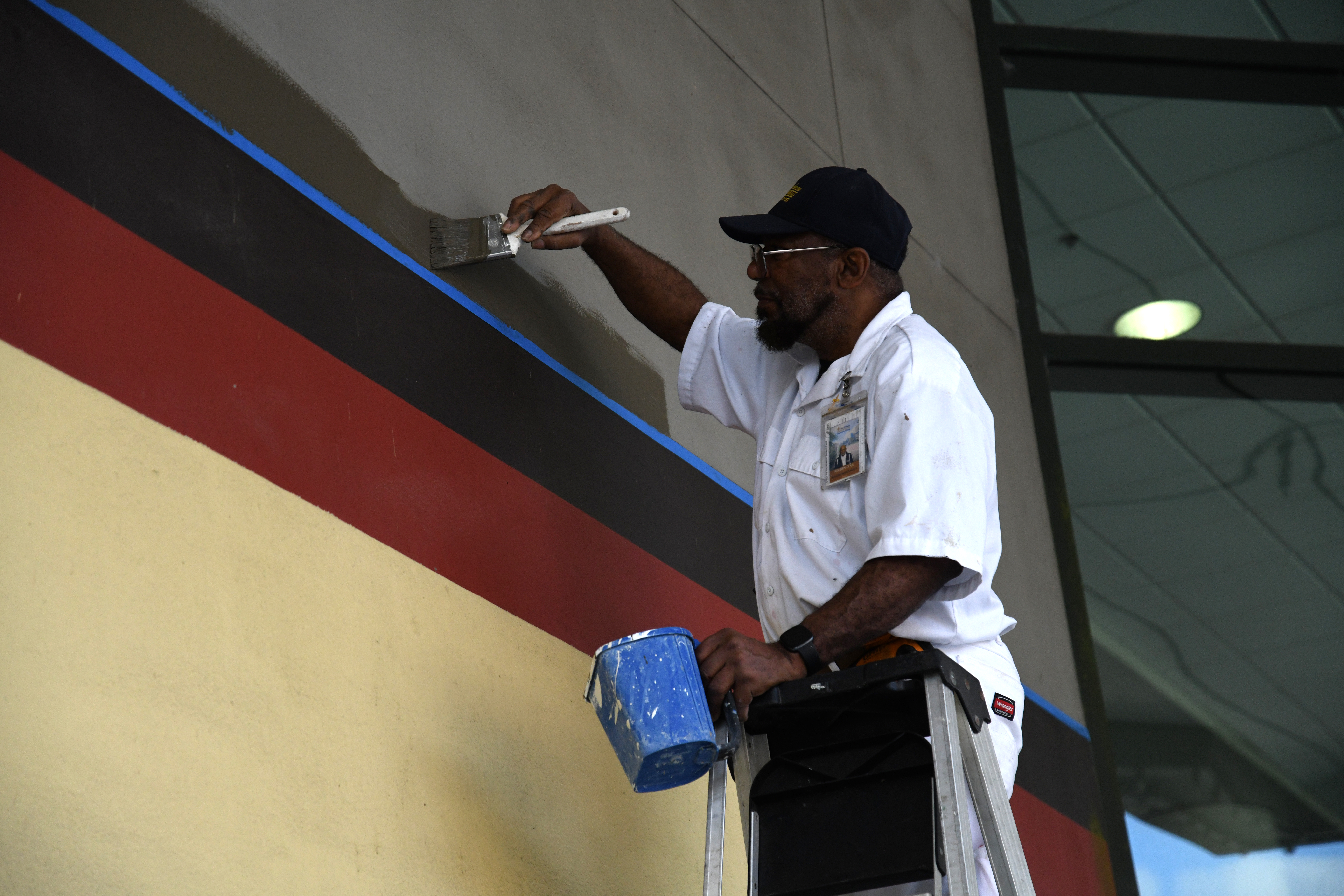
Sometimes you just have to say no! I know a painter who encountered some overly optimistic and prickly clients. He went through the whole spiel and explained why it was in their best interest to wait until spring. Undeterred, they kept pointing out “the 35-degree thing” until it became a hollow refrain. Fed up, he finally told them — and I’m paraphrasing — “It may be good down to 35, but this painter isn’t. I’m moving inside for the season.”
I can’t compare Maine to the other 49 States, but I do enjoy the tales of my southwestern brethren who enjoy a far longer season than we do here. As far as advice to anyone looking to relocate here, I’d caution that Maine summers, like other northern states, are desperately short and entirely unpredictable. I think it was four or five years ago we got snow in some capacity for nine months straight, from September until May. Granted, the snow in May melted away quickly but when you’re on a 40-foot ladder painting trim and the snow and sleet starts falling from nowhere ... well, it can elicit a foul mood and some choice words.
I guess the rest is “obvious,” as the kids say. Keep your vehicle warm, and don’t make the mistake of leaving paint on the floorboards “until later.” When the wind chill is -50, it won’t take long for that $80/gallon paint to freeze.
Painting in Alaska allows Ben Campbell of Anchorage-based Campbell Painting some spectacular views and vistas, but when he’s not looking at the snow-capped peaks, he’s busy keeping painters and equipment from freezing or trying not to overschedule the summer. Campbell explains some of the techniques he uses to keep the paint flowing and the customers happy.
There is no magic trick for making sure your jobs withstand Alaskan winters. I may be younger than some long-time painters up here, but I have the old-school mindset of each step properly being completed before moving on to the next.
Paint manufacturers come out with paint and primer in one. This means nothing in Alaska, as multiple different surfaces need a specific type of primer. Most Alaskan homes have wood siding, so our go-to primer is XIM Peel Bond. This primer is like glue! We always back-roll, so it gets pushed into the grooves in the wood. Another thing that helps is we tint the primer to 50% of the color of the top coat, so when we spray the top coat, you can see the variation but it covers beautifully over top.
Another important thing is to make the house or building watertight by caulking all windows, doors, and or any openings. This winter, we are having a record snowfall. What do you think is going to happen in the springtime when all this snow melts? Water always takes the least path of resistance and will find a way into the home.
Do not skimp on the paint; spend the extra $10-$15 per gallon to put the premium paint on. We use Benjamin Moore Regal Low Luster. We have a short exterior season, depending on the year it starts sometime in May and goes through the beginning of September, and depending on the product, the surface we are painting has to be above 40 degrees at night for us to apply the paint. May, June, and July are the best months because when August and September come, so does the rain. August last year was the 3rd rainiest in Alaska history! I always tell my customers that farmers love the rain and painters hate it.
With such a short season for painting exteriors, scheduling becomes a complete nightmare. We had about 20 properties from last summer bleed over into this summer. Alaskans know this and most of them completely understand, but a lot of homeowners get frustrated when they can’t find a painter to do interior work in the summertime. It is such a short season, so we have to put all our efforts into the exterior jobs to try to complete as many as possible. If the customer is flexible and understanding, we can put them on our “rainy-day list.” If the weather calls for a week of rain or the temperatures drop too low in the morning, we will tackle some interior jobs.
So many painters are so anxious to do exterior work that they push it too early in the spring or too late in the fall. Whatever surface you are painting has to be a specific temperature, not just what your weather app says it is. Metal doors, for example, have to be 50 degrees. The air may be 50 degrees outside but if the doors are on the north side of the building, where they don’t get hit by the sun, they will be much colder. The paint will not cure properly and will fail within a year. Also, beware of paint freezing.
This is a big problem in Alaska because a lot of homeowners put it in their garage on the concrete floor right next to their garage door. Once it has a hard freeze, the paint is not good anymore and you have to dispose of it in the city dump.
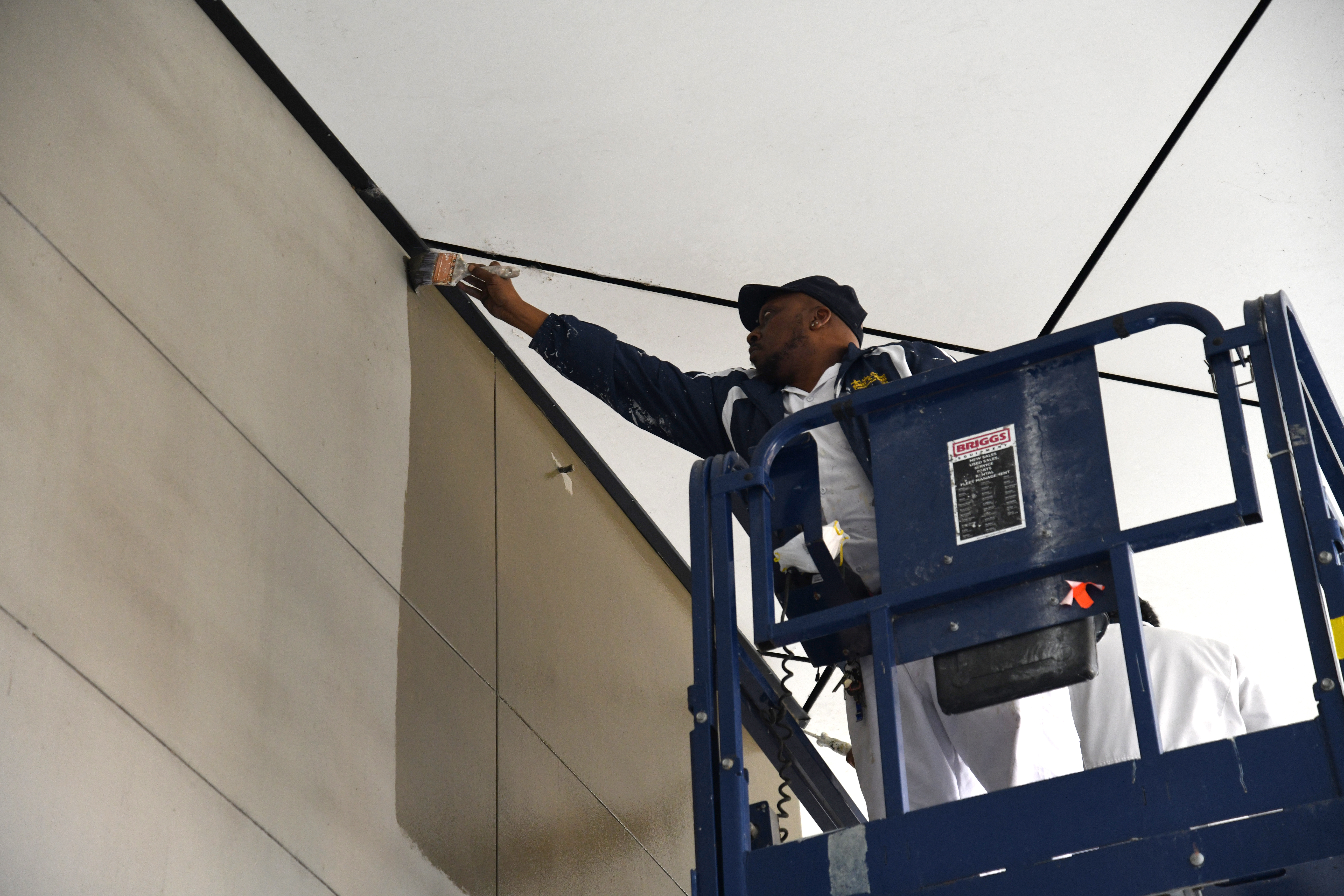
Whether you’ve been there or you haven’t, New Orleans’ unique culture conjures up strong images: Mardi Gras, crawfish, occasionally the Saints, and for our purposes, hot, humid, languid days where watching paint dry is impossible because it just won’t. The city hosts a lot of conventions to take advantage of all the fun that can be had, and it keeps the Ernest N. Morial Convention Center paint crew busy all year long.
Before we paint, and before we prep, even before we get to work in the morning at 5:30 to beat the heat, working in this community begins with self-care and teamwork. John Johnson, the Morial Center’s building maintenance paint foreman, makes sure his team is healthy both physically and mentally so they have the stamina and the attitude to get the job done. Hot one day, chilly the next, riding up a lift at the break of dawn or before, the job needs people ready and able to go at it and stay at it.
“I’m big on health — the reason is because this weather can change you,” he said. “I like to make sure my crew is up on their health screening. Your water intake, vitamin intake, fruits, and vegetables, and getting the proper sleep, all play a big part in this job because when you’re dealing with 95 today and 50 tomorrow, that can affect your health. If you’re not up on that, you’re sick, and if you’re sick, you’re not working.”
Mental health is just as important, as getting everyone on board with what’s to be done and working as a team. “In my crew, we’re like family. We’re tight,” said Johnson. “I like to be on one accord with my crew. I don’t just sit here and give orders and point fingers. If you come here and you can be a fly on the wall, you’re going to say one thing — that man gets in there. I like to get in, I like to get dirty with you. No, I don’t have to, but that’s why I’m sitting in the position I’m sitting in now.” Johnson believes that the attitude from the top is what keeps them going in all types of weather. “I would stress to communicate with your crew. Me getting in there helping them, they see that drive that I have that’s going to make them do the same thing. If you’re sitting there lollygagging, it’s a ripple effect, so I’m not giving them that.” One worker playing on their phone can domino through the team. “They get mad because, ‘Well, why is this one here?’ But if we’re all on one accord, we’re going to jump on it, we’re going to knock it out and we can relax.”
Johnson keeps at least one eye on the forecast. If it’s going to be hot, he’s got to know in advance so the crew can start early and so the paint stays put when the sun gets to work after the crew goes home. It might mean a 5:30 start time, but this also gives the paint enough time to dry before the sun revs up. By applying the paint too close to the heat of the day, Johnson notes, the outside of the coating dries first while what’s underneath stays moist, leading to bumps, wrinkles, and other problems that will take time and money to address later. This kind of scheduling is also helpful for the crew’s health and safety. “If I know it’s going to be 95 degrees at noon, I’ve already scheduled my crew to come in and start working at the break of dawn,” he said. “By the time the heat starts to peak, we either finish the job or we’re through for the day because I’m not going to have my crew out in that type of extreme temperature. When you’re dealing with over a hundred-degree weather, it’s simply not safe to be painting or be outside at all.”
But it’s not always hot. “It can be 82 degrees today and tomorrow morning it’s 51,” said Johnson. “When we are dealing with colder weather the paint tends to become thicker, making it more difficult to apply and take longer to dry. The thicker the paint, the more likely it is to have flaws in the finish — runs, drips, sagging. In addition, the colder weather can also mess with binding to the surface you’re painting which can lead to either chipping, peeling, or uneven results.”
Josh Fornoff co-owner and, operations manager of MTS Painting in Mesa, Arizona, tells us that in the summer season, more or less May through October, hydration is the most important part of their safety measures for crew in the field. While product and technique matter, keeping the team healthy and able to work during hot weather is foremost for their foremen. “Our trucks are loaded with five-gallon water jugs that are continuously refilled with ice blocks and topped off with fresh water daily,” said Fornoff. “We encourage the crew to bring lunches with a little bit of salt, and snacks like nuts or trail mix to help replenish the sodium they sweat out during the day. Back at the shop, we provide free Gatorade and electrolyte popsicles when they finish their day.”
The good news is that it doesn’t usually hit 110 or higher until after 2 p.m., so a 6 a.m. start time, or earlier if the facility allows it, can allow the team to put in a full day’s work and break before they bake. Sometimes, though, you have to give the “win” to the sun. “On days when it’s getting that hot by midday or if the humidity is up and temperature is getting close to 110, we will pull the crew back into the shop and find miscellaneous work for them to finish the day,” said Fornoff.
Staying safe in the heat puts added importance on job sequencing, he adds. As much as possible, they want their team working in the shade, it’s good for the painters as well as the paint, as the crew can be a little cooler and the surface temperatures are in range for proper paint application. Sometimes, says Fornoff, the paint needs a drink as well. “Adding water (per manufacturer instructions) or extenders is often needed for the paint to flow out properly when it’s really hot and dry.”
Arizona’s lower humidity gives it an advantage over some other toasty climes; Fornoff explained that the “dry heat” actually makes a difference. “When it’s hot you sweat, but when it’s dry that sweat evaporates quickly and therefore cools you down quickly. When the air is humid, the evaporation happens much slower and because of that, you can overheat much easier. For us in the desert, the second half of the summer is our monsoon season and that’s when it gets ‘nasty’ outside. 105+ and 40% humidity is when it’s the most dangerous for us.”
Thinking of relocating here? “Move here in the early spring so your body can acclimate slowly,” Fornoff advises. “Every day it gets a little hotter and you get used to it. If you show up in the summer, the heat is going to kick your butt for at least a couple weeks!”
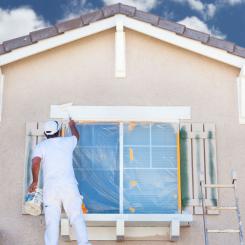
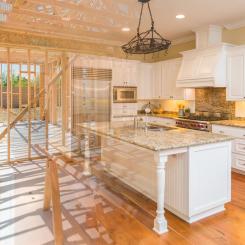
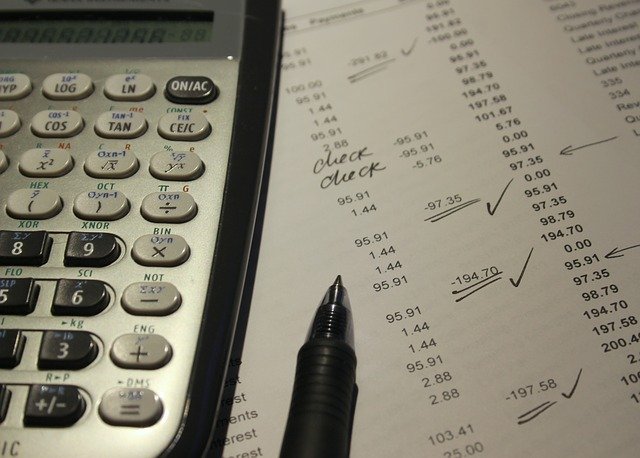

Add new comment